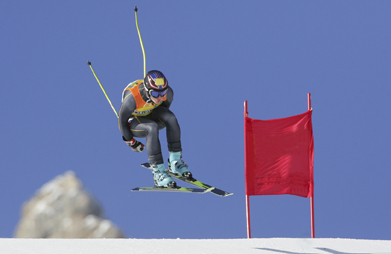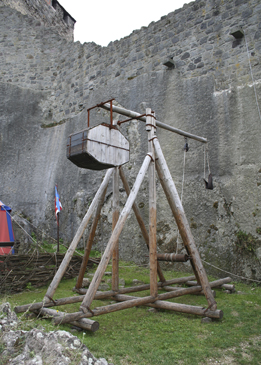Module 3
1. Module 3
Module 3 Introduction
Have you ever wondered how the crash site of a satellite that has fallen from orbit is found? Or, perhaps more mundanely, have you wondered how long and how far you’re airborne on a ski hill? There is mathematics to do these things!

© karaboux/6098970/Fotolia
Most objects, whether thrown, shot, launched, or somehow projected into the air, follow a particular shaped path. For example, when a ski racer becomes airborne cresting over a rise, she or he rises to a certain point and then begins to drop back to the ground. The same is true of a skateboarder performing a jump.
The path of a projectile, called its trajectory, can be modelled using a quadratic function. Quadratic functions can be used to model many different situations.
In this module you will investigate the following inquiry questions:
- How can quadratic functions be used to model real-world problems?
- How can quadratic equations be used to solve problems?
To investigate these questions, you will focus on the following lessons and corresponding inquiry questions listed in the table.
|
Lesson |
Title |
Lesson Inquiry Questions |
|
1 |
Investigating Quadratic Relations |
How do you recognize a quadratic function? |
|
How do the values of a, b, and c in the standard form |
||
|
2 |
Graphs of Quadratic Functions |
What characteristics of a quadratic function can be identified from the graph of the function? |
|
How can you tell the number zeros of a quadratic function given the coordinates of the vertex and the value of a in the quadratic function? |
||
|
3 |
Quadratic Functions and Graphing Calculators |
How can you use a graphing calculator to draw the graph of a quadratic function? |
|
How can you use a graphing calculator to identify the coordinates of the vertex, domain and range, axis of symmetry, and x- and y-intercepts of the graph of a quadratic function? |
||
|
4 |
Vertex Form of Quadratic Functions |
How is the graph of a quadratic function affected by a change in the constants a, h, and k in the vertex form, y = a(x − h)2 + k? |
|
How do you convert from vertex form to standard form and back? |
||
|
How do you solve problems using a quadratic function in vertex form? |
||
|
5 |
Factored Form of Quadratic Functions |
How is the graph of a quadratic function related to the constants r and s in the factored form, y = a(x − r)(x − s)? |
|
How do you sketch the graph of a quadratic function in the factored form? |
||
|
How do you solve problems using a quadratic function in the factored form? |
||
|
6 |
Binomial and Trinomial Factoring Review |
What processes can be used to fully factor binomials and trinomials? |
|
How can you use a quadratic equation in factored form to find the roots of the quadratic equation? |
||
|
How can you explain the relationships among the roots of an equation, the zeros of the corresponding function, and the x-intercepts of the graph of the function? |
||
|
7 |
Solving Quadratic Equations by Factoring or Graphing |
How can you use a quadratic equation in factored form to solve problems involving the zeros of the corresponding quadratic function or the x-intercepts of the graph of the function? |
|
How can you find the roots of a quadratic equation by graphing the corresponding quadratic function? |
||
|
8 |
Solving Quadratic Equations Using the Quadratic Formula |
How can you solve a quadratic equation without using factoring or graphing? |
|
How can you use the discriminant to find the number of roots a quadratic function will have? |
||
|
How do you solve problems using the quadratic formula? |
||
|
9 |
Solving Problems with Quadratic Equations |
How do you write a quadratic function that models a given situation and explain any assumptions made? |
|
How do you solve a problem, with or without technology, by analyzing a quadratic function? |
Module 3 Project

© Canoneer/1324569/Fotolia
The project for Module 3 involves using quadratic functions to compare the trajectories produced by three different teams in a launch contest. You will use the skills learned in this module to compare the heights and distances of projectiles using tables, graphs, and equations. You will have to convert between these methods of expression to decide the winner.
For specific instructions, refer to the Module 3 Project.
Strategies for Success
You may find the following strategies useful to support your success in this module.
Strategy 1: Course Glossary
Recall from the course introduction that you will be building your own version of a glossary in Mathematics 20-2. As you encounter new terms in the lesson, you can add them to your Glossary Terms document. You should have started a Glossary Terms document in Module 1 and saved it to your course folder. If not, save the Glossary Terms document now to your course folder.
Strategy 2: Notes Organizer
A notes organizer is a tool for recording key concepts, terms, formulas, examples, or tips from each lesson in one place to refer to as you work through the course. Notes can be organized in a variety of formats. If you have not done so already, take a look at the Notes Organizer document for some ideas.
Strategy 3: Supplementary Resources

© youpee2305/26879651/Fotolia
You will be referring to Chapter 6 (pages 318 to 391) and Chapter 7 (pages 392 to 439) of the Principles of Mathematics 11 textbook for Module 3. Take time to flip through these textbook pages. Look at illustrations, margin features, and main titles to get a sense of where you will be going in this module.
There are also resources available on LearnAlberta.ca. Your teacher can provide you with a username and a password to access content on LearnAlberta. An Internet search can also provide you with useful information. Just remember to consider the source of the information.
It’s launch time! In Lesson 1 of Module 3: Quadratics you will prepare for launch with a look at what makes a relation a quadratic function.